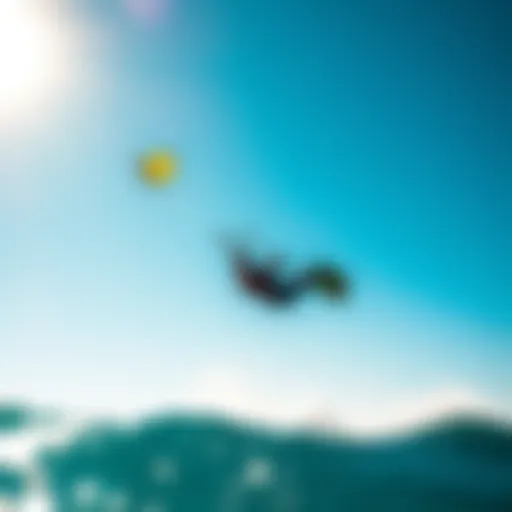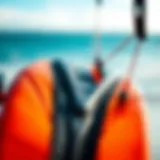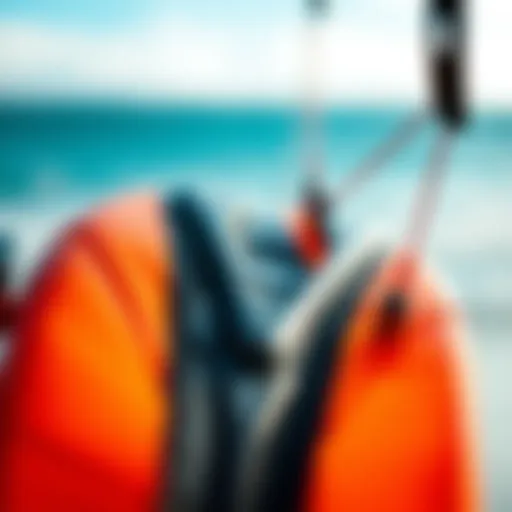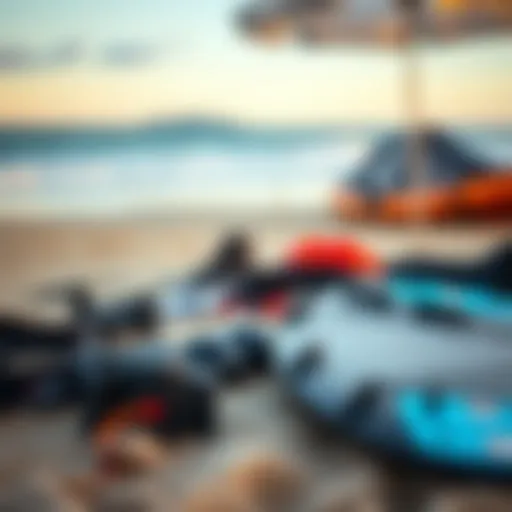Key Benefits of 6 4 Wetsuits for Kiteboarding


Intro
Diving into the world of kiteboarding, one must recognize the pivotal role that gear plays in ensuring an exhilarating yet safe experience. Among the gear essentials, 6/4 wetsuits have carved a niche for themselves, especially for those braving the colder waters. Understanding the intricate details of these wetsuits can give kiteboarders a significant edge in performance and comfort.
In this article, we’ll explore distinctive features and advantages of 6/4 wetsuits, focusing on their materials, thermal efficiency, and anatomical designs that optimize performance on water. We’ll also compare them against other wetsuit thicknesses, discuss the ideal conditions for wear, and provide maintenance tips. By the end, you’ll be better equipped to choose the right wetsuit tailored to your regional climate and personal preferences.
Gear Insights
When it comes to gear essentials for kiteboarding, having the right wetsuit is paramount. A well-chosen wetsuit not only keeps you warm but also enhances your movements, allowing for improved agility and responsiveness on the board.
Latest Gear Reviews
- Ninja 6/4 Wetsuit: This suit has earned high marks for flexibility and thermal protection. The inner lining is cozy while the exterior resists wind, making it ideal for choppy days.
- Dare 6/4 Wetsuit: With its seamless construction, this wetsuit offers unparalleled freedom of movement. Kiteboarders rave about its snug fit and the ability to layer effectively for colder temps.
- HydroFlex 6/4 Wetsuit: An excellent choice for the more budget-minded. The HydroFlex balances warmth with affordability, though it sacrifices a bit on flexibility.
Essential Gear for Beginners
Starting in kiteboarding can feel like navigating a labyrinth, especially with the pressure of selecting the right gear. If you're just venturing into this sport, consider the following:
- Comfortable Fit: Ensure your wetsuit fits snugly without constricting your movements. This is crucial for those awkward first-timer tumbles.
- Insulation: Look for a wetsuit that balances thickness with comfort. A 6/4 wetsuit is usually perfect for cooler waters without being overly restrictive.
- User Reviews: Don’t just take the manufacturer’s word for it. Dive into an authoritative resource like Reddit to hear experiences from seasoned kiteboarders.
"Choosing a wetsuit isn’t just about thickness. It's about how it works with your entire setup. A snug wetsuit means better performance" – A seasoned kiteboarder on Reddit.
Techniques and Tips
The right wetsuit lays the foundation, but mastering kiteboarding techniques and adhering to safety practices elevate the experience.
Advanced Tricks and Techniques
As you progress beyond the basics, you may want to try these tricks:
- The Back Loop: A spectacular aerial move requiring practice and confidence, best pulled off with a responsive wetsuit.
- Riding Waves: The big leagues of kiteboarding. Your wetsuit should allow fluid movements while braving waves.
Safety Practices for Kiteboarders
Lastly, prioritize safety. Here are vital practices to keep in mind while kiteboarding:
- Buddy System: Never head out alone, especially when you’re still learning the ropes.
- Condition Watch: Always monitor weather reports. Kiteboarding in dangerous conditions can be a recipe for disaster.
- Wear a Harness: While it doesn't relate directly to wetsuits, a good harness enhances the overall control you have during kiteboarding.
Understanding Wetsuit Thickness
Wetsuit thickness is a pivotal factor when choosing the right suit, especially for kiteboarding enthusiasts. It’s not just about comfort; it directly affects heat retention, buoyancy, and overall performance in the water. In many respects, understanding wetsuit thickness lays the groundwork for making informed choices as a kiteboarder, allowing for optimal performance in varying conditions.
What Does Mean?
When we talk about a 6 4 wetsuit, we refer to its thickness in millimeters. Specifically, the first number ‘6’ signifies the thickness of the rubber in the torso area, while the ‘4’ indicates the thickness in the limbs, such as arms and legs. The rationale behind this design choice is straightforward: core warmth is paramount, as losing heat from the body can lead to a significant decrease in performance and comfort. By keeping the core thicker, a 6 4 wetsuit helps retain essential body heat while allowing for more flexibility in the limbs, thus enabling better movement and maneuverability.
It's important to remember that different activities and conditions might require different thicknesses. In kiteboarding, where a mix of speed and agility is essential, having that slightly thinner material in the arms and legs makes it easier to control the kite and maintain balance. This balance of insulation and mobility is exactly what many kiteboarders look for.
Thickness Implications for Water Sports
The thickness of a wetsuit affects various variables critical to water sports, especially kiteboarding. Aside from warmth retention, thicker wetsuits tend to offer greater wind protection and buoyancy. Here are some implications to consider:
- Thermal Efficiency: Wettouits with more thickness can trap body heat more efficiently, which is crucial during colder months or in chilly water.
- Flexibility: While thicker materials are beneficial for insulation, they can also reduce flexibility if not designed correctly. A well-constructed 6 4 wetsuit maintains a good balance between warmth and ease of movement.
- Resilience Against Wear and Tear: Thicker material tends to be sturdier, making it less prone to damage from elements like coral underneath the sea or even the kite lines themselves.
- Adaptability to Weather: In regions with variable temperatures, a 6 4 wetsuit can provide adaptability, allowing users to ride comfortably across various conditions.
In short, understanding the thickness of your wetsuit plays a key part in ensuring your kiteboarding experience is both enjoyable and safe. The right choice can mean the difference between feeling comfortable and being cold or restricted in movement. So, pay attention to your needs and the conditions you plan to face – it’s all part of mastering the art of kiteboarding.
"A 6 4 wetsuit doesn’t simply keep you warm; it empowers your adventure on the water."
As you weigh your options, remember that the right wetsuit is not just a piece of equipment; it’s a vital aspect of your kiteboarding journey.
Materials Used in Wetsuits
Neoprene Varieties: Which is Best?
In the evolution of wetsuits, neoprene stands as the unsung hero, playing a crucial role in ensuring warmth, flexibility, and overall performance in colder waters. The choices in neoprene varieties can be a bit overwhelming, but understanding their distinct characteristics can help kiteboarders make informed decisions. Broadly, neoprene can be categorized into closed-cell and open-cell variants.
- Closed-cell neoprene is often firmer and provides better insulation, making it a popular choice for those chilly, windy days. It keeps water out, which means you’ll stay warmer.
- Open-cell neoprene, on the other hand, offers superior flexibility and is usually lighter. This variant hugs the body perfectly, but may lack some insulating properties compared to its closed-cell counterpart.
When considering which type is best for you, think about your personal comfort and the conditions you’ll be riding in. For instance, if you frequently find yourself battling frigid temperatures, leaning towards a closed-cell wetsuit could be the smart choice. Conversely, if speed and agility are top priorities, opt for open-cell neoprene.
Ultimately, the best neoprene for kiteboarding depends not just on material but on personal preference and riding style. Keep in mind that the right combination of materials can also drastically affect flexibility, weight, and durability of the wetsuit.
Eco-Friendly Alternatives
In an age where sustainability is gaining traction, many kiteboarders are exploring eco-friendly alternatives to traditional neoprene. This shift isn’t just a passing trend; it's a response to the growing awareness of environmental impact.
Yulex is one of the leading eco-friendly materials available. It's derived from natural rubber, making it a highly sustainable option. Yulex maintains performance standards similar to traditional neoprene while reducing reliance on petroleum-based materials. Kiteboarders looking to make a conscious choice should give Yulex serious consideration.
Other exciting innovations include wetsuits made from recycled plastics. Companies are experimenting with tech that transforms discarded plastic bottles into functional, durable wetsuits. This not only reduces waste but also gives a second life to materials that would otherwise harm the environment.
"Using sustainable materials is not merely a matter of personal preference, it’s a commitment to preserving the waters we love to ride."
As you consider your next wetsuit purchase, weigh the long-term benefits of selecting environmentally friendly options that lessen your carbon footprint and contribute to the health of our oceans. This approach to materials signifies a powerful change in the industry that aligns with the values of many adventurers today.
Advantages of Wetsuits
When considering gear for kiteboarding, the importance of the wetsuit cannot be overstated. A 6 4 wetsuit, with its specific thickness of 6mm in the torso and 4mm in the limbs, offers distinct advantages tailored to this exhilarating sport. The balance of warmth, flexibility, and comfort make it a go-to choice for many enthusiasts.
Thermal Protection and Comfort
One of the standout features of a 6 4 wetsuit is its exceptional thermal protection. Kiteboarding is often done in cooler waters where chills can easily creep in, especially when you're out for hours. A well-designed wetsuit acts like a second skin, creating a barrier that holds warmth close while keeping the water out.


Imagine gliding across the water, wind in your face, only to be hit by a sudden wave that splashes icy water. A good wetsuit, like the 6 4 type, traps a layer of water inside that warms up due to your body heat. This insulation means you can keep riding without feeling the bite of the cold. Not only does it keep your body temperature stable, but it also enhances overall comfort, allowing for longer sessions on the water.
"The right wetsuit is like having your own personal weather shield. It’s not just about warmth; it’s about confidence on the water."
Moreover, the internal linings of modern 6 4 wetsuits are often designed with soft materials to enhance comfort. Wearing a wetsuit that feels good against your skin can make all the difference during extended kiteboarding trips. Besides, the suits are styled to minimize chafing, which can be a real thorn in the side, bringing added comfort to an already demanding sport.
Flexibility and Ease of Movement
In kiteboarding, agility and range of motion are essential. Nobody wants to feel restricted while trying to catch the perfect wave or execute a complicated trick. A 6 4 wetsuit excels here, as it provides a blend of warmth and flexibility.
The flexible areas often found in the designs of these wetsuits, particularly in the limbs, allow for a greater range of motion. While the thickness in the torso area offers warmth, the 4mm thickness in the arms and legs ensures that you can still maneuver freely. Whether you’re reaching for the control bar or transitioning between tricks, these wetsuits make it all feel seamless.
Additionally, many brands have incorporated advanced stretch materials that enhance this flexibility even further. Features such as articulated joints and ergonomic cuts ensure that the suit moves with you rather than against you. In kiteboarding, this advantage cannot be overlooked; it directly contributes to performance and can ultimately influence the success of each ride.
Being able to twist, jump, and shift your weight easily is something kiteboarders treasure. Having a 6 4 wetsuit can make that possible without compromising your thermal needs. Overall, the advantages of these wetsuits add considerable value to one’s kiteboarding experience, aligning perfectly with the sport’s demands.
Ideal Kiteboarding Conditions
The conditions under which kiteboarding takes place can incredibly influence both performance and enjoyement. Kiteboarders depend on a combination of weather patterns and water temperatures to create an optimal atmosphere for high-flying stunts or endless cruising along the coastline. Understanding these elements is not just a matter of convenience; it's about maximizing safety and performance while riding the wind and waves.
Weather Considerations
Weather plays a pivotal role in kiteboarding, but not in the way one might think. Sure, a sunny day often feels better than an overcast one, but what really matters is the wind. Before heading out, it's wise to check local wind conditions and patterns.
- Wind Speed: Ideal riding conditions typically require winds blowing between 12 to 25 knots. Too little wind means you're stuck bobbing around, while winds exceeding 30 knots can lead to dangerous conditions.
- Wind Direction: Cross-shore winds are often considered the best for kiteboarding. They offer the necessary lift without driving the rider too close to the shore or posing a risk of getting pulled into the beach.
- Weather Systems: Seasonal weather patterns can dictate when to hit the water. For example, winter storms may provide consistent winds in some regions, while summer often offers lighter breezes combined with warmer air.
Remember, a little pre-planning based on the weather can turn a mediocre day into an exhilarating experience.
Riders might also consider monitoring potential weather changes throughout the day. A sudden shift in forecasts can alter conditions quickly, making it vital to remain alert while on the water.
Optimal Water Temperatures
Next on the list is understanding how water temperature impacts kiteboarding experiences. The amount of insulation provided by a 6 4 wetsuit becomes essential here. Cooler waters demand thicker wetsuits to ensure comfort and safety.
- Comfort Level: Water temperatures below 60°F (about 15°C) will generally lead you to choose the thicker 6 4 wetsuit. It's not just about avoiding discomfort; prolonged exposure to cold water can be a health risk.
- Performance Impact: When the water is too cold, it affects mobility, and that may lead to unwanted stiffness. With the right wetsuit, your limbs should remain flexible and responsive, allowing you to catch air easily or carve through the waves.
- Personal Tolerance: Everyone has different levels of comfort with cold water, so it’s worth considering individual tolerance. Some might find 65°F (18°C) to be quite pleasant, while others will begin to feel the chill.
Comparative Analysis with Other Wetsuit Thicknesses
When it comes to choosing the right wetsuit for kiteboarding, the thickness is a key factor. In this section, we deep dive into how 6 4 wetsuits stack up against other thicknesses, especially 4 3 suits, to understand the practical implications of such choices. The nuances in thickness can change your kiteboarding experience entirely—comfort, warmth, flexibility—all play critical roles in how well you enjoy your time on the water.
vs. 4: A Practical Examination
The debate between 4 3 and 6 4 wetsuits often boils down to your specific needs and the conditions you plan to tackle.
- Warmth:
- Flexibility:
- Intended Use:
- The 6 4 suit provides significantly more warmth due to its thicker neoprene, making it ideal for chillier waters. You can almost picture yourself out there in late autumn, wind whipping around, while you remain cozy beneath that extra layer.
- Conversely, a 4 3 wetsuit offers decent warmth and is typically sufficient for spring or early fall conditions. If the water isn’t particularly frigid, you might feel a bit too toasty in a 6 4.
- While the 6 4 excels in thermal protection, it’s often heavier and less flexible than your average 4 3. Kiteboarding requires agility; too much bulk can make maneuvers tricky, especially when the wind is howling.
- A 4 3 suit gives you that sweet spot where warmth and flexibility meet. Hazardous conditions, maneuvers needing split-second timing, they should feel less burdensome?
- If you engage in kiteboarding sessions during the coldest months, the 6 4 is your go-to choice. Beyond just performance, the psychological comfort of knowing you won’t freeze makes a massive difference.
- On the flip side, summer kiteboarding ease is best served with a 4 3 or even less. Think of those sunny stretches when temperatures rise, and you need something that’s breathable and light.
"Assess what regions and times of year you’ll be kiting the most. Your wetsuit choice can be make or break for both comfort and performance."
When to Choose a Thicker or Thinner Wetsuit
Now that we’ve explored the differences between the 4 3 and 6 4, it helps to clarify when you might want to reach for one thickness over another.
- Cold Water Climates: If you live or frequently kiteboard in regions where the water temperature dips considerably, the 6 4 wetsuit becomes not just an option but a necessity, especially during the winter months.
- Chilly Breezes: Situations with high winds can make waters feel colder than they are. Opting for a thicker wetsuit here would eliminate much discomfort stemming from wind chill. Your body can only take so much before it sends signals you just can’t ignore.
- Warm Water Conditions: If you’re heading to tropical destinations, a thinner wetsuit or even a shorty might suit your fancy. No one wants to overheat while riding—suffering can become more of an annoyance than fun.
In essence, the proper thickness should enhance your kiteboarding experience rather than compromise it. Take into consideration factors like water temperature, time of year, and your personal comfort level with colder or warmer wetsuit models.
Maintenance and Care Tips
When talking about 6 4 wetsuits, it's essential to highlight the maintenance and care involved. Proper care can significantly enhance the wetsuit's lifespan while ensuring it performs at its best during those exhilarating kiteboarding sessions. Not only does this enhance your investment, but it also shapes your overall experience on the water. Here's a closer look at how to care for your wetsuit, focusing mainly on cleaning and storage practices.
Cleaning Your Wetsuit
Caring for a wetsuit might seem straightforward, but it goes beyond a quick rinse after a day on the water. When you're done kiteboarding, first, make sure to correctly rinse off any saltwater, sand, or chlorine from your suit. A fresh water rinse is your wetsuit’s best friend. This helps in preventing the material from breaking down over time.
- Immediate Care:
- Gentle Wash:
- Drying:
- As soon as you get off the water, turn your wetsuit inside out and rinse it under a cold tap for at least five minutes. This flushes out the salt and grime.
- Use a wetsuit cleaner or a mild shampoo for a deeper clean when it’s needed. Scrub it gently with your hands or a soft cloth. Harsh chemicals can be a death knell for neoprene, so avoid those.
- After washing, hang your wetsuit to dry in a shaded area, avoiding direct sunlight, which can degrade the material. Never use a tumble dryer or hang it in direct heat.
"Taking the time to properly clean your wetsuit can save you from costly replacements in the long run!"
Storage Best Practices
Once your wetsuit is clean and dry, the next step is storing it correctly to avoid unnecessary damage. A little attention in this area goes a long way in prolonging the life of your wetsuit. Here are a few tips to consider:
- Hanging vs. Folding: Always hang your wetsuit, preferably on a broad hanger, to prevent creasing, which can weaken the neoprene. If you must fold it, ensure there’s no pressure on the seams.
- Cool Environment: Store your wetsuit in a cool, dry place. Avoid basements or places with moisture that can lead to mold development.
- Avoid Heavy Loads: Do not pile other gear on top of your wetsuit. It may seem harmless, but consistent weight can deform its shape and compromise fits.
- Check for Pests: If you have a storage area prone to insects, keep an eye out for pests that may want to make a home in your wetsuit. Regularly check your gear can save you from unpleasant surprises.
By following these maintenance and care tips, you can ensure your 6 4 wetsuit remains a reliable companion on the waves.
Selecting the Right Fit
Getting the right fit for your wetsuit might seem like a small detail, but in the realm of kiteboarding, it’s akin to finding the right pair of shoes for a marathon. A wetsuit that fits like a glove can enhance your performance, increase comfort, and even prolong your time on the water. Conversely, a poorly fitting wetsuit may lead to discomfort or impede your movements, making every ride feel burdensome. Ultimately, when you are soaring over waves, escaping a fall, or navigating tricky winds, the last thing you want to be worried about is a loose or tight wetsuit.


Body Measurements to Consider
To choose the best fit, you first need to arm yourself with the right body measurements. Here’s a brief rundown of the key dimensions to consider:
- Chest Size: Measure around the fullest part of your chest. This will help ensure a snug fit that keeps warmth in without constricting your movements.
- Waist Size: A proper waist measurement will ensure the wetsuit stays in place while you’re kiteboarding, preventing any unwanted slips.
- Hip Size: This measurement affects the thigh area of the wetsuit. It’s especially important for athletes with varying body shapes.
- Inseam: For full-length wetsuits, the inseam measurement from your crotch to your ankle will ensure that the legs fit correctly without being too long or short, which might lead to extra drag or restriction.
- Height and Weight: These elements are essential, as most wetsuit brands will provide sizing charts that correlate to both factors.
It's a good idea to consult the sizing charts provided by manufacturers; however, not all brands size their wetsuits the same. This means you may want to try several brands to find the most comfortable fit.
Common Sizing Issues
Even the most seasoned kiteboarders can fall victim to sizing issues. As simple as it may seem, not all bodies are formed equally, and wetsuit sizing can vary widely. Here are a few common pitfalls:
- Too Loose: If a wetsuit is too baggy, it can create excess water flow. This not only makes you cold faster but can also be cumbersome when trying to stay agile on the board.
- Too Tight: A wetsuit that feels restrictive can limit your movement. If you find yourself struggling to perform basic kiteboarding maneuvers, it may be time to reassess your fit.
- Compromised Length: Make sure that the arms and legs aren't too short. A wetsuit that pulls up while you're moving can create leaks and also hinder your performance.
"A wetsuit that fits properly will not only feel comfortable but also protect you better against the elements. Don’t cut corners when it comes to fit; it’s crucial for every kiteboarder."
Finding the right fit might take a little legwork, but the payoff during your kiteboarding adventures will be well worth the effort. Always remember, the comfortable fit can keep you riding longer and more efficiently. Whether you're out for a casual ride or pushing your limits, the right wetsuit makes all the difference.
Innovative Features in Modern Wetsuits
In the ever-evolving world of kiteboarding, having the right gear can make all the difference. It's not just about picking a good brand; modern wetsuits are bursting with innovative features that cater specifically to the needs of kiteboarders. These advancements not only enhance comfort but also significantly improve overall performance in the water. By understanding these elements, kiteboarders can make informed choices that offer them both protection and agility.
Added Insulation Technologies
The trend of incorporating added insulation technologies in wetsuits is a game-changer for kiteboarding enthusiasts. Traditional neoprene has been enhanced with various thermal materials to provide better heat retention without sacrificing flexibility. For instance, some wetsuits utilize closed-cell foam layers that trap heat, ensuring warmth in cooler waters. This technology doesn't overpower the suit's flexibility, allowing kiteboarders to maneuver with ease.
Key Benefits of Added Insulation:
- Enhanced Warmth: Riders can spend extended hours on the water without succumbing to the chill.
- Lightweight Design: Many modern wetsuits are lighter than ever due to innovative insulation materials, making them less cumbersome during a session.
- Comfortable Fit: Improved thermal liners ensure the suit hugs the body snugly, providing both warmth and comfort without creating excess bulk.
When considering insulation, it’s crucial to select a wetsuit that balances warmth with flexibility. Look for those that offer thermal properties without weighing you down. As a kiteboarder, being agile can make the difference between a smooth ride and one filled with struggles against the elements.
Seam Construction Advances
Another vital area of innovation in modern wetsuits is seam construction. The way seams are stitched or sealed greatly impacts a suit's overall durability and comfort. Advanced techniques like blind stitching and taping seamlessly combine insulation and waterproofing properties, offering kiteboarders more confidence when braving the waves.
Seams are where many wetsuits can fail, allowing water to seep in and robbing you of heat. Enhanced seam technologies have reduced these occurrences significantly. Key advancements include:
- Blind Stitched Seams: These are stitched but not completed through to the outer layer, effectively minimizing water entry.
- Taped Seams: These feature a protective layer over the stitching, greatly enhancing the durability of the suit and its waterproof capabilities.
- Liquid Taping: This process involves applying a liquid rubber to the seams, creating an extremely strong barrier against leaks.
"The seams are not just lines on your suit; they are the frontline defenders of your thermal comfort and performance in harsh conditions."
In short, selecting a well-constructed wetsuit with advanced seam technology can mean the difference between a satisfactory day on the water and coming in prematurely due to cold or discomfort. Adequate attention to seam detail can save kiteboarders from unpleasant surprises mid-session.
At the end of the day, investing in a wetsuit that embodies these innovative features not only enhances a kiteboarder's experience but also tailors the suit to withstand the rigors of this exhilarating sport.
Cost Considerations
When diving into the world of 6 4 wetsuits for kiteboarding, the cost aspect is a crucial factor. It's not just about the initial price tag but understanding the value that a good wetsuit can add to your kiteboarding adventures. The right wetsuit can make a world of difference in comfort, durability, and overall enjoyment on the water.
Firstly, it's essential to recognize that cheap wetsuits might save you a few bucks upfront. However, these lower-cost options may quickly lead to disappointment. They often lack the thermal protection and flexibility that serious kiteboarders need. So, it’s wise to weigh the long-term benefits against immediate costs.
Investing in a quality wetsuit will often mean better materials, more comprehensive protective features, and increased lifespan. Not to mention how it may enhance your performance and comfort.
Budget Options vs. High-End Wetsuits
When considering budget options vs. high-end wetsuits, the distinction typically lies in materials, construction techniques, and features.
- Budget Options: These wetsuits might be made of thinner neoprene or less flexible materials. They can be a decent choice for occasional kiteboarders or those just starting out. However, they may not provide the warmth needed for longer sessions in colder waters.
- High-End Wetsuits: These often utilize superior materials and advanced techniques. Expect increased warmth from thicker neoprene layers, superior seam construction, and added insulation technologies. Higher-end models might include features like reinforcement in areas subject to wear, better anatomical fit, and improved flexibility. Investing in these options provides significant long-term advantages.
For many kiteboarders, the ultimate decision often falls into their favor based on how frequently they plan to use their wetsuit. A serious rider may find that spending in the higher range pays off far better than settling for something that might fall apart after a few months.
Long-Term Value of Investment
Thinking about long-term value is vital with a purchase like a wetsuit. The saying "You get what you pay for" rings true in this field. A quality wetsuit can last several years with proper care. This durability dramatically reduces the cost per season or session.
- Resilience: High-quality wetsuits resist wear and tear better, maintaining their thermal efficiency and flexible nature over time.
- Performance: For avid kiteboarders, the ability to perform at peak levels is tied to comfort and functionality. A wetsuit that stands the test of time facilitates that performance without constant need for replacement.
- Resale Value: If you ever decide to upgrade or change your wetsuit, high-end brands often hold their value better in the second-hand market. This aspect is another piece of the puzzle that can influence the overall financial picture of your wetsuit purchase.
In summary, while the costs of wetsuits can vary significantly, evaluating these expenses through the lens of longevity and performance can lead to a wise investment choice. Ultimately, not just the price point, but the full picture of benefits is what you should consider.
Region-Specific Recommendations
When it comes to kiteboarding, choosing the right wetsuit goes beyond just picking the right thickness or material. The region where one intends to ride significantly influences the decision-making process regarding wetsuit selection. Factors such as climate, water conditions, and local wildlife all play a crucial role in ensuring both comfort and safety on the water.
Understanding these region-specific nuances is paramount, as it directly contributes to not just an enjoyable experience but also optimal performance. In this section, we will delve into the particular wetsuit requirements for coastal areas and explore how freshwater and saltwater environments dictate different considerations for kiteboarders.
Wetsuit Needs for Coastal Areas
For surfers and kiteboarders spending their time along the coast, the natural variances in temperature and water depth call for a careful consideration of wetsuit needs.
- Temperature Variability: Coastal areas can often experience fluctuating temperatures throughout the day and across seasons. During warmer months, it may be tempting to wear a lighter wetsuit or none at all, but early morning sessions or late evenings can be a different story entirely.
- Stronger Currents: Coastal waters can harbor more powerful currents compared to inland bodies of water. A thicker wetsuit not only provides warmth but also offers extra protection against abrasions and potential impacts, which is particularly useful when dealing with more challenging conditions.
- Marine Life Considerations: Depending on the specific coastal region, the presence of sea creatures can be a factor. Jellyfish, for example, can pose a threat in some areas; a thicker wetsuit can offer added protection against unexpected encounters with wildlife.
With these elements in mind, it’s easy to see why kiteboarders in coastal regions may favor 6 4 wetsuits during certain seasons, balancing the need for thermal insulation and flexibility in their movements.
Considerations for Freshwater vs. Saltwater
The decision-making process doesn't stop with just coastal needs; the type of water conditions also plays a significant role. There are some crucial differences in wetsuit requirements for freshwater versus saltwater kiteboarding:
- Water Temperature: Generally, freshwater bodies, like lakes, tend to warm up faster than saltwater oceans. This may lead to the conclusion that thinner wetsuits could suffice in certain situations. However, factors such as wind chill can quickly offset this comfort, making it necessary to evaluate your choice carefully.
- Salinity Effects: Saltwater can enhance buoyancy; hence, some kiteboarders feel slightly warmer in it, compared to a freshwater environment. Nonetheless, it is essential to keep in mind that saltwater can also lead to quicker degradation of the wetsuit material unless it’s rinsed off well after each session.
- Debris and Environment: Freshwater locations may contain more debris, such as branches or rocks, than saltwater conditions. This necessitates a thicker wetsuit in freshwater settings for protection against cuts and scrapes that could arise during kiting.
Choosing the right wetsuit can mean the difference between an enjoyable session and a miserable experience. Each rider is unique, and understanding specific regional requirements is key.


Overall, both coastal conditions and the nature of the water underscore the importance of personalizing wetsuit choices based on individual surroundings. Making informed decisions can amplify a kiteboarder's experience, whether gliding across the glassy surface of a lake or tackling ocean swells.
Kiteboarding Techniques for Enhanced Comfort
When it comes to kiteboarding, comfort is more than just a pleasant feeling; it directly influences performance and control on the water. A proper stance combined with efficient body movements can make a noticeable difference in achieving better balance and agility. The nuances of how one interacts with the kite and board are crucial, and knowing the right techniques goes a long way.
Adjusting Stance and Movements
Finding the right stance is key in kiteboarding. A stance that is too wide or too narrow can affect stability and flow when riding. Typically, a comfortable stance should be shoulder-width apart, giving you a solid base. Think of it like standing on a skateboard—your feet should neither be too far apart nor too close together, allowing for efficient weight transfer.
- Knees slightly bent: Keeping your knees bent can help absorb the terrain's bumps and give you that extra agility to respond to the kite’s pull. Imagine bending a spring; it becomes more flexible, just like you.
- Hips facing forward: Keeping your hips aligned with your shoulders can improve your control over the board. If your hips are swaying, it’s akin to walking down a tightrope while wobbling; you’re bound to lose balance.
Adapting your movements based on wind conditions is also vital. For instance, in stronger winds, you may choose to crouch lower to stabilize your stance. Conversely, gentler winds might allow for a more upright position. Adjustments should happen intuitively, aligning your body mechanics with the kite’s dynamics.
Utilizing Equipment Synergy
Another layer to enhancing comfort while kiteboarding lies in the synergy between your equipment and your riding technique. Using the right gear makes a world of difference. Think of it as an orchestra; when all instruments harmonize, the music flows beautifully. In kiteboarding, that harmony exists between the kite, board, and the rider.
- Kite Selection: The choice of kite can significantly impact your riding experience. For energetic conditions, a smaller, quicker kite allows nimble maneuvers, while a larger kite can offer more lift in lighter winds. Knowing how to match your kite size to the wind's intensity can create an effortless riding experience.
- Board Type: Different boards respond uniquely to different conditions. A directional board excels in carving and speed, while a twin-tip board provides versatility for freestyle moves. Selecting the right board for the day’s conditions can elevate your performance.
- Adjusting Lines and Harness: Don't overlook the significance of your lines and harness. Ensure your lines are tuned properly; this makes a difference similar to adjusting your brakes on a bike. An ill-fitting harness could cause discomfort and lead to performance issues.
"To navigate the winds effectively, one must find harmony between their movements and the tools they wield."
By honing your stance and movements in conjunction with optimizing equipment synergy, kiteboarding transforms from merely riding on water to an art form. These adjustments lead not just to better performance but to a more enjoyable experience on the water.
In the end, comfort isn’t just a side note; it shapes every aspect of your kiteboarding experience, pushing the boundaries of what you can achieve.
Seasonal Considerations for Wetsuit Use
When choosing a wetsuit for kiteboarding, understanding the seasons is crucial. Wetsuits are designed for various temperature ranges, and knowing how to align your gear with seasonal changes can make or break your experience on the water. This section dives into the specifics that kiteboarders should consider as they adapt to shifting climates.
The weather can dramatically change not just your comfort but also your safety while kiteboarding. Ranging from chilly winds in spring to warmer breezes in summer, each season presents unique challenges and opportunities.
Best Seasons for Wetsuits
The 6 4 wetsuit truly shines during specific seasons. Here’s a closer look at when to pull this thick suit out from storage:
- Autumn: As summer departs, ocean temperatures drop, but kiteboarding continues to thrive, particularly in warmer coastal regions. A 6 4 wetsuit provides essential warmth while letting you enjoy the thrill of those crisp winds.
- Winter: For those adventurous spirits who seek to fly over icy waters, a 6 4 wetsuit is almost a necessity. It keeps you insulated against cold water temperatures, ensuring your body stays warm during those long sessions. The additional thickness allows you to remain on your board longer without succumbing to the chill.
- Early Spring: Like autumn, spring can be a tricky mix of cold water and warming air temperatures. A 6 4 is ideal here, balancing warmth without overheating as the sunshine starts to come back out.
Some regions may experience mild winters wherein a thinner suit suffices, but if you're in colder waters, opting for the thickness of a 6 4 is always the safer bet.
Transitioning Between Thicknesses
As kiteboarders navigate through seasons, knowing when to transition between wetsuit thicknesses is key. Making the correct choice ensures optimal performance and comfort.
- Temperature Awareness: Check local water temperature charts, as many kiteboarding locations offer detailed guides on what thickness to wear based on the season. It’s not just about air temperature; water temps play a vital role in comfort level.
- Personal Comfort: Everyone has unique tolerance to cold. Some riders might still feel warm in a 4 3 as temperatures drop; others might need to switch to a thicker suit earlier. Don’t hesitate to test it out and trust your instincts.
- Layering: If you're not ready for a complete switch, layering can serve as a stopgap. Adding rash guards or thermal vests under thinner wetsuits might help extend your riding period as the seasons change.
In short, adjusting your wetsuit based on the season not only enhances your performance but also helps in enjoying kiteboarding more fully and safely. With expertise and awareness, it’s easier to ride the waves, no matter the weather.
User Experiences and Feedback
User experiences and feedback offer invaluable perspectives when it comes to selecting the right wetsuit, particularly the 6 4 wetsuits for kiteboarding. These insights can greatly influence purchasing decisions as they provide real-life anecdotes that highlight both advantages and drawbacks of the product. From the excitement of warmth during cold sessions to complaints about fit or movement restrictions, user feedback paints a comprehensive picture. Analyzing these insights helps potential buyers to adjust their expectations and make more informed choices.
Common User Reviews
Many kiteboarders rave about the thermal efficiency of 6 4 wetsuits, especially in frigid waters. Users often express relief at how warm they feel, even when the air temperature drops. A consistent point raised in reviews is the impressive quality of the neoprene material, which tends to hold up well against wear and tear. For instance, one user noted, "I've had my 6 4 suit for two seasons, and it still feels like new!" This highlights the durability that many kiteboarders appreciate in their wetsuits.
On the flip side, some reviews do spotlight challenges with the fit. While many find the 6 4 wetsuit snug yet comfortable, a handful of users have noted issues with flexibility. One reviewer mentioned, "It kept me warm, but sometimes I felt like I was wearing a cast while trying to maneuver on the board." This feedback is crucial, pinpointing the balance between warmth and mobility — an essential aspect for performance in kiteboarding.
Influential Factors in Satisfaction
Several key factors influence user satisfaction with 6 4 wetsuits, and examining these can provide useful insights for both manufacturers and consumers.
- Fit and Comfort: A well-fitting wetsuit not only provides warmth but also enhances performance. Users often emphasize the importance of body shape and personal measurements, as an ill-fitting suit can lead to discomfort and hinder movement.
- Material Quality: The type and quality of neoprene play significant roles in user satisfaction. Many reviews highlight how superior materials impact insulation and stretchability, making the experience more enjoyable in various conditions.
- Price vs. Performance: Many kiteboarders are conscious of their budget while also desiring a high-performing product. The correlation between cost and quality is frequently discussed, with users often sharing their thoughts on whether the performance aligns with the price tag.
- Brand Reputation: Some users tend to favor well-established brands known for their quality and reliability. They often report higher satisfaction levels, feeling reassured by the brand's reputation regarding customer service and warranty policies.
"A wetsuit should be as much about comfort as it is about the ability to perform. A poor fit can make even the best quality material feel worthless."
— Anonymous User
Understanding these influential factors not only aids in making informed decisions but also helps manufacturers refine their products to better meet user needs. Thus, the feedback collected is not just a narrative of experiences; it serves as a guiding compass for future innovations in wetsuit technology.
Culmination and Final Thoughts
When it comes to kiteboarding, the choice of wetsuit can mean the difference between an enjoyable day on the water and a soggy experience that ends too soon. As discussed throughout this article, a 6 4 wetsuit isn't just a piece of gear; it's a key player in ensuring comfort, safety, and performance. In the turbulent winds and chilly waters—whether you’re a seasoned pro or just dipping your toes into the sport—understanding the characteristics and capabilities of the wetsuit is imperative.
This guide has delved into various aspects of 6 4 wetsuits, shedding light on their unique thickness, materials, and advantages. We have explored how well these wetsuits insulate against cold while providing the flexibility necessary for intense kitesurfing maneuvers. Being aware of this empowers kiteboarders to make informed choices, catering to their specific needs based on the conditions in which they will be riding.
Moreover, from maintenance tips to understanding the technology behind modern wetsuits, the insights provided help in preserving your investment and enhancing your experience on the water. It’s not just about looking good while kiteboarding; it’s about optimizing your outfit for efficiency, comfort, and protection.
"Wetsuits are not merely functional gear; they are your second skin in the water, adapting to warmth while minimally restricting your movements."
Adapting to seasonal changes with the right thickness becomes critical, as does knowing when and how to transition between wetsuits. This ensures that you can face varying weather conditions without a hitch. Whether kiteboarding off the coast or hanging out by a lake, understanding your wetsuit's role is key to your enjoyment and success.
Recapping Key Insights
To reiterate the focal points:
- Wetsuit Thickness: The 6 4 wetsuit balances warmth and flexibility, making it suitable for cooler waters.
- Material Matters: Different neoprene types affect comfort and durability.
- User Experience: Understanding comfort preferences helps in selecting a fit that enhances performance.
- Maintenance and Care: Proper upkeep extends the life of your wetsuit, ensuring it performs well when you need it most.
Remind yourself that kiteboarding skills can only get you so far; pairing these skills with the right gear maximizes your time on the water.
Future Trends in Wetsuit Technology
As we look ahead, the evolution of wetsuit technology appears promising. Manufacturers are constantly innovating, creating lighter, more flexible materials that provide thermal insulation without the bulk.
- Smart Wetsuits: There’s buzz about integrating technology into wetsuits, such as temperature-regulating fabrics that adapt to body heat, ensuring optimal comfort across varying temperatures.
- Sustainable Options: A surge in eco-conscious designs is likely to emerge. Companies are exploring alternatives to conventional neoprene, opting for more eco-friendly materials that don’t compromise performance. The call for environmental responsibility in watersports can’t be ignored.
- Customized Fits: Expect to see advancements in tailored designs that cater to specific body types, maximizing comfort and usability while minimizing water entry.
The future is bright for kiteboarders as the gear evolves in ways that enhance safety, comfort, and performance on the water.
Ultimately, staying informed about these trends can help kiteboarders make choices that align with their values and improve their overall experience.















